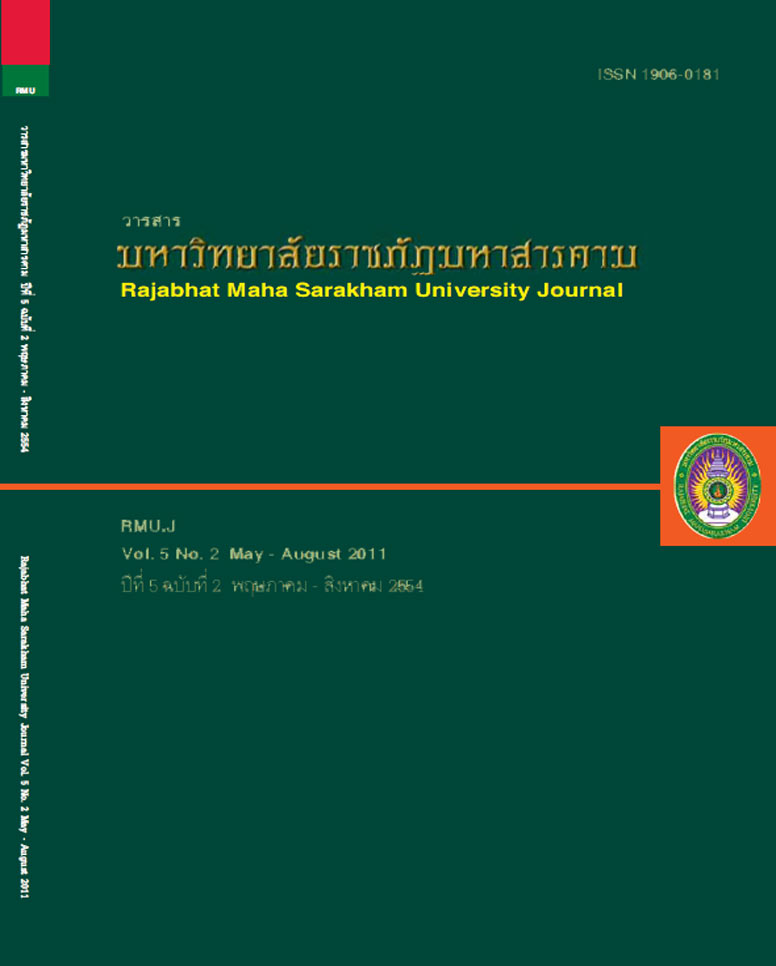การพัฒนารูปแบบการฝึกอบรมครูแบบผสมผสานในการทำวิจัยในชั้นเรียน; The Development of Blended Teachers Training Model in Classroom Research
Main Article Content
Abstract
การวิจัยครั้งนี้มีวัตถุประสงค์ ประการแรก เพื่อพัฒนารูปแบบการฝึกอบรมครูแบบผสมผสานในการทำวิจัยใน
ชั้นเรียน โดยใช้วิธีการวิจัยและพัฒนา (Research and development) และประการที่สอง เพื่อประเมินประสิทธิภาพของ
รูปแบบโดยใช้ CIPP Model เครื่องมือที่ใช้ในการวิจัย ได้แก่ รูปแบบการฝึกอบรมครูแบบผสมผสานในการทำวิจัย
ในชั้นเรียนที่ผู้วิจัยพัฒนาขึ้น กลุ่มตัวอย่างแบ่งเป็น 3 กลุ่ม ได้แก่ 1) กลุ่มผู้เชี่ยวชาญในการพัฒนารูปแบบการฝึกอบรม
จำนวน 17 คน 2) กลุ่มผู้เชี่ยวชาญในการประเมินหลักสูตร จำนวน 5 คน 3) ครู จำนวน 20 คน ผลการวิจัยพบว่า
1. รูปแบบการฝึกอบรมครูตามความคิดเห็นของผู้เชี่ยวชาญโดยใช้เทคนิคเดลฟาย รูปแบบการผสมผสานใน 2 ลักษณะ
1) วิธีการฝึกอบรมระหว่างการฝึกอบรมเชิงปฏิบัติการและการเรียนรู้ระหว่างปฏิบัติงาน โดยวิธีการฝึกอบรม แบ่งเป็น
3 ขั้นตอน ดังนี้ 1.1) การอบรมเชิงปฏิบัติการ ระยะที่ 1 ”พัฒนาเค้าโครง เชื่อมโยงนวัตกรรม นำความรู้สู่ห้องเรียน„ จำนวน 2 วัน
1.2) การเรียนรู้ระหว่างปฏิบัติงาน ”พากเพียรรวบรวมข้อมูล เพิ่มพูนกัลยาณมิตร„ 1.3) การอบรมเชิงปฏิบัติการ ระยะที่ 2
”คิดวิเคราะห์ สรุปผล ฝึกฝนเขียนรายงาน„ จำนวน 2 วัน 2) กิจกรรมการฝึกอบรม 8 ลักษณะ ได้แก่ การบรรยาย สนทนากลุ่ม
การนำเสนอผลงาน การฝึกปฏิบัติ การแลกเปลี่ยนเรียนรู้ การนิเทศติดตามแบบกัลยาณมิตร การให้คำปรึกษาทางโทรศัพท์ และ
จดหมายอิเล็กทรอนิกส์
2. ประสิทธิภาพของรูปแบบการฝึกอบรม ขั้นเก็บรวบรวมข้อมูล เท่ากับ 88.16/83.50 สูงกว่าเกณฑ์ที่กำหนดไว้ คือ
80/80 ดัชนีประสิทธิผลของรูปแบบการฝึกอบรม มีค่า 0.6235 คิดเป็นร้อยละ 62.35 แสดงว่า ผู้เข้ารับการฝึกอบรมมีความ
ก้าวหน้าทางการเรียน ความคิดเห็นของผู้เข้ารับการฝึกอบรมที่มีต่อการฝึกอบรม ค่าเฉลี่ยโดยรวมอยู่ในระดับมากที่สุด ผู้เข้ารับ
การฝึกอบรมทุกคน ทำรายงานการวิจัยในชั้นเรียนมีคุณภาพอยู่ในระดับดี
This research aimed to: firstly, develop blended teachers training model in classroom research.
The research and development approach was used through this research and secondly, evaluate the
efficiency of the training model based on CIPP model. The instruments used for data collection consisted
of blended teachers training model in classroom research developed by the researcher. The samples
used in this research were divided into three groups: 1) 17 experts with developing the training model,
2) 5 experts with curriculum evaluation, and 3) 20 teachers, under the Office of Buriram Educational
Service Area 4. The results can be summarized as follows:
1. According to the opinion of the experts, there were two characteristics of the blended teachers
training model in classroom research by using the Delphi Technique: 1) training while doing the workshop
and learning on the job. The training method was divided into 3 steps: 1.1) the 2-day workshop phase
1: ‘Develop the structure, connect the innovation, take the knowledge to the classroom’ 1.2) learning on
the job: ‘Persevere to collect data, accumulate true friends’, 1.3) 2-day workshop phase 2, ‘Think
and analyze, summarize, train to write the report’, 2) 8 types of training activity: lecture, focus group
discussion, presentation, training, learning and sharing, supervision and follow-up as a true friend,
telephone consultation, and e-mail.
2. The efficiency of the training model on the step of data collection was 88.16 / 83.50 which
was higher than the established criteria of 80/80. The effectiveness index of the training model was at
0.6235 which was indicated that 62.35 percent of trainees had progressed in their learning. The opinion
of trainees towards the training model was at the highest level as a whole. Every trainee has also done
a high quality report.
Article Details
1. All articles undergo a thorough with at least three reviewers evaluating their suitability within the respective field of study, during the double-blind review.
2. The views expressed by individual authors do not represent the official views of the Editorial Boards of RMUJ: The author of each articie is responsible for all its contents.
3. The Editorial Boards do not reserve the copyrights. but proper citations need to be made.

